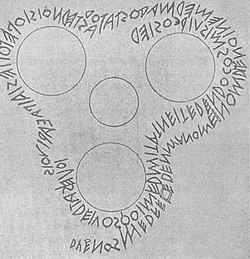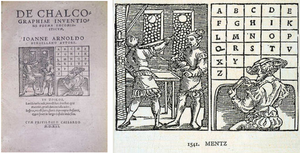Latin alphabet
| Latin | |
|---|---|
 | |
| Script type | |
Time period | c. Latin characters in Unicode |
| History of the alphabet | ||
|---|---|---|
|
||
|
||
| Part of a series on |
| Calligraphy |
|---|
 |
The Latin alphabet, also known as the Roman alphabet, is the collection of letters originally used by the
Etymology
The term Latin alphabet may refer to either the alphabet used to write Latin (as described in this article) or other alphabets based on the
Evolution
The Latin alphabet evolved from the visually similar
Signs and abbreviations
Although Latin did not use diacritical marks, signs of truncation of words (often placed above or at the end of the truncated word) were very common. Furthermore, abbreviations or smaller overlapping letters were often used. This was due to the fact that if the text was engraved on stone, the number of letters to be written was reduced, while if it was written on paper or parchment, it saved precious space. This habit continued even in the Middle Ages. Hundreds of symbols and abbreviations exist, varying from century to century.[3]
History
Origins
It is generally believed that the Latin alphabet used by the
That alphabet was derived from the Euboean alphabet used by the Cumae, which in turn was derived from the Phoenician alphabet.[citation needed]Old Italic alphabet

| Letters | 𐌀 | 𐌁 | 𐌂 | 𐌃 | 𐌄 | 𐌅 | 𐌆 | 𐌇 | 𐌈 | 𐌉 | 𐌊 | 𐌋 | 𐌌 | 𐌍 | 𐌎 | 𐌏 | 𐌐 | 𐌑 | 𐌒 | 𐌓 | 𐌔 | 𐌕 | 𐌖 | 𐌗 | 𐌘 | 𐌙 | 𐌚 |
|---|---|---|---|---|---|---|---|---|---|---|---|---|---|---|---|---|---|---|---|---|---|---|---|---|---|---|---|
| Transliteration | A | B | C | D | E | V | Z | H | Θ | I | K | L | M | N | Ξ | O | P | Ś | Q | R | S | T | Y | X | Φ | Ψ | F |
Archaic Latin alphabet
| As Old Italic | 𐌀 | 𐌁 | 𐌂 | 𐌃 | 𐌄 | 𐌅 | 𐌆 | 𐌇 | 𐌉 | 𐌊 | 𐌋 | 𐌌 | 𐌍 | 𐌏 | 𐌐 | 𐌒 | 𐌓 | 𐌔 | 𐌕 | 𐌖 | 𐌗 |
|---|---|---|---|---|---|---|---|---|---|---|---|---|---|---|---|---|---|---|---|---|---|
| As Latin | A | B | C | D | E | F | Z | H | I | K | L | M | N | O | P | Q | R | S | T | V | X |
Old Latin alphabet
Latin included 21 different characters. The letter ⟨C⟩ was the western form of the Greek
| Letter | A | B | C | D | E | F | Z | G | H | I | K | L | M | N | O | P | Q | R | S | T | V | X |
|---|
Classical Latin alphabet
After the
| Letter | A | B | C | D | E | F | G | H | I | K | L | M | N | O | P | Q | R | S | T | V | X | Y | Z |
|---|---|---|---|---|---|---|---|---|---|---|---|---|---|---|---|---|---|---|---|---|---|---|---|
| Latin name (majus) | á | bé | cé | dé | é | ef | gé | há | ꟾ | ká | el | em | en | ó | pé | qv́ | er | es | té | v́ | ix | ꟾ graeca | zéta |
| Transliteration | ā | bē | cē | dē | ē | ef | gē | hā | ī | kā | el | em | en | ō | pē | qū | er | es | tē | ū | ix | ī Graeca | zēta |
| Latin pronunciation (IPA) | aː | beː | keː | deː | eː | ɛf | ɡeː | haː | iː | kaː | ɛl | ɛm | ɛn | oː | peː | kuː | ɛr | ɛs | teː | uː | iks | iː ˈɡraɪka | ˈdzeːta |

The Latin names of some of these letters are disputed; for example, ⟨H⟩ may have been called
The letter ⟨Y⟩ when introduced was probably called "hy" /hyː/ as in Greek, the name
The primary mark of punctuation was the interpunct, which was used as a word divider, though it fell out of use after 200 AD.
centuries AD by Latin and Greek scribes. Tironian notes were a shorthand system consisting of thousands of signs.Medieval and later developments


It was not until the
With the fragmentation of political power, the
The languages that use the
See also
- Latin spelling and pronunciation
- Calligraphy
- Euboean alphabet
- Latin script in Unicode
- ISO basic Latin alphabet
- Latin-1
- Legacy of the Roman Empire
- Palaeography
- Phoenician alphabet
- Pinyin
- Roman letters used in mathematics
- Typography
- Western Latin character sets (computing)
- Spread of the Latin script
References
- ^ "Sylheti language and the Syloti-Nagri alphabet". www.omniglot.com. Retrieved 8 March 2024.
- ^ Michael C. Howard (2012), Transnationalism in Ancient and Medieval Societies. p. 23.
- ISBN 88-203-1100-3.
- ^ "Etruscan alphabet | Etruscan Writing, Ancient Scripts & Language". Britannica. Retrieved 17 October 2023.
- ^ Liberman, Anatoly (7 August 2013). "Alphabet soup, part 2: H and Y". Oxford Etymologist. Oxford University Press. Retrieved 3 October 2013.
- ISBN 9780521530330– via Google Books.
Further reading
- Jensen, Hans (1970). Sign Symbol and Script. London: George Allen and Unwin Ltd. ISBN 0-04-400021-9. Transl. of Jensen, Hans (1958). Die Schrift in Vergangenheit und Gegenwart. Deutscher Verlag der Wissenschaften., as revised by the author
- Rix, Helmut (1993). "La scrittura e la lingua". In Cristofani, Mauro (hrsg.) (ed.). Gli etruschi – Una nuova immagine. Firenze: Giunti. pp. S.199–227.
- Sampson, Geoffrey (1985). Writing systems. London (etc.): Hutchinson.
- Wachter, Rudolf (1987). Altlateinische Inschriften: sprachliche und epigraphische Untersuchungen zu den Dokumenten bis etwa 150 v.Chr. Bern (etc.).: Peter Lang.
- ISBN 0-521-22049-1.
- Biktaş, Şamil (2003). Tuğan Tel.
